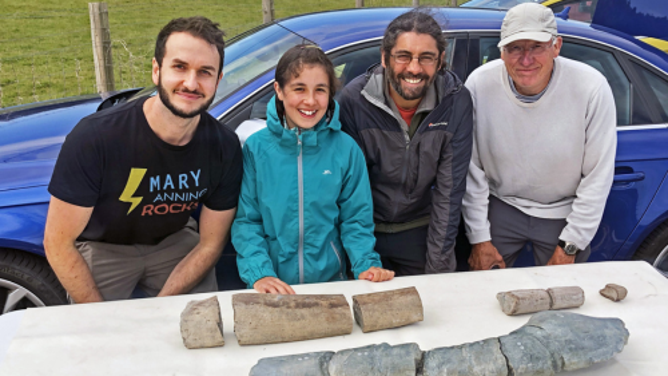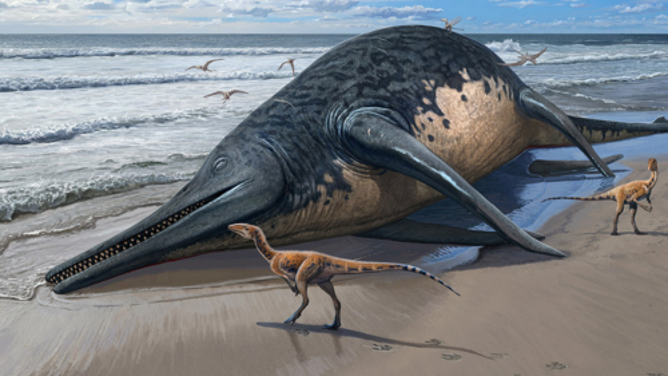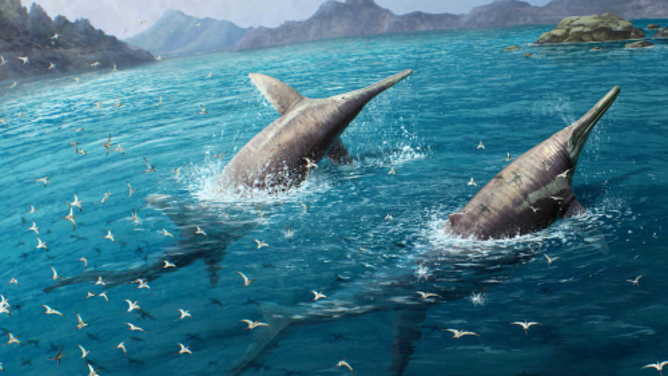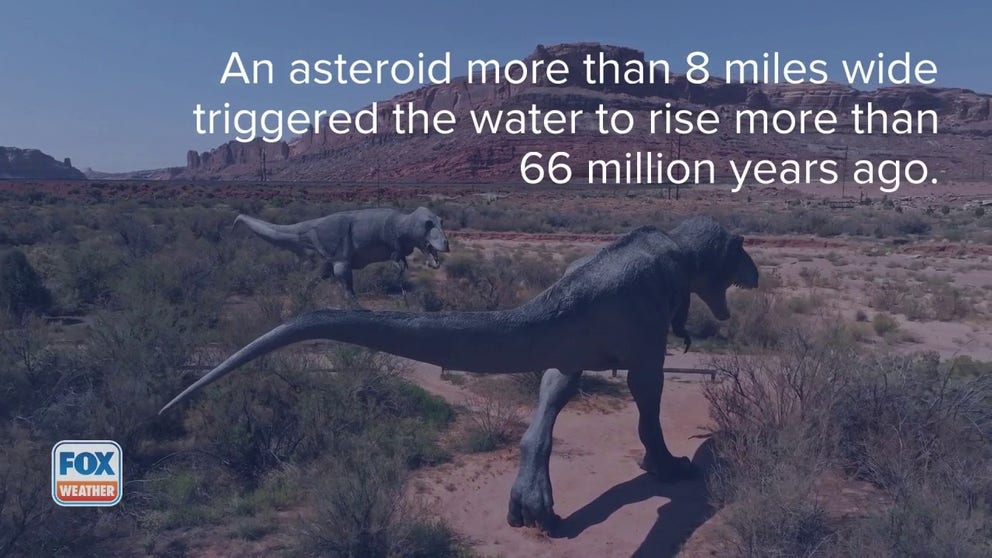Father-daughter 202 million-year-old fossil find could be largest prehistoric marine reptile
Ruby, then 11, and her father, Justin Reynolds, found the first piece of the second jawbone in May 2020. Experts have identified the bones as belonging to a newly discovered species of prehistoric marine reptile that would have measured 65-feet long.
Dinosaur-killing asteroid triggered a tsunami with mile-high waves
An asteroid that struck Earth 66 million years triggered a megatsunami that wiped many of the dinosaurs
An 11-year-old girl on a fossil hunt with her father uncovered a chunk of jawbone, leading paleontologists to later identify the bones as belonging to a previously unknown titan of the prehistoric ocean.
On Tuesday, scientists published a study in the journal PLOS ONE about the fossil finds, concluding that the bones are those of a new species of the enormous ichthyosaur, a prehistoric marine reptile estimated to be more than 65 feet long.
The fossil hunt began eight years ago when fossil collector Paul de la Salle found the first giant jawbone in 2016 along Lilstock Beach in Somerset, England.
Fast-forward four years later, Ruby Reynolds, then 11 years old, found a chunk of giant bone, later confirmed to be a piece of the second jawbone.

Part of the research team in 2020 examining the initial finds (at the back) of the new discovery made by Ruby and Justin Reynolds. Additional sections of the bone were subsequently discovered. From left to right, Dr Dean Lomax, Ruby Reynolds, Justin Reynolds and Paul de la Salle. (Photo credit: Dr Dean Lomax)
According to the University of Bristol, Ruby and her father, Justin Reynolds, contacted paleontologist Dean Lomax about their find. Lomax and his team, including de la Salle, had found yet another piece of giant bone in 2018 in Blue Anchor, further down the coast from the original find.
The piece of fossil found by Ruby led to a multiyear hunt for more pieces of the multimillion-year-old jigsaw puzzle.
The father and daughter, along with Lomax and his team, continued hunting for more pieces, finding additional pieces of the same jaw.
The team recovered the final piece of jawbone in October 2022.
FOSSIL OF 240-MILLION-YEAR-OLD 'DRAGON' UNEARTHED IN CHINA
Lomax's research team named the new genus and species Ichthyotitan severnensis, which means "giant fish lizard of the Severn." According to the University of Bristol, the species would have been about as large as a blue whale.

An artist rendering of a washed-up Ichthyotitan severnensis carcass on the beach. (Image: Sergey Krasovskiy)
According to Lomax, these bones are unique because they appear about 13 million years after the latest giant ichthyosaurs, providing strong evidence for a new species.
Core samples of the bones helped research team member Marcello Perillo, from the University of Bonn in Germany, determine the bones' origin and that the reptile wasn't fully grown when it died.
The bones are 202 million years old, predating the global extinction event that ended the reign of marine reptiles that size.
An inspiring paleontologist and published scientist at 15 years old
Ruby, now 15, became a published scientist this week when the study came out about the discovery.
"I was highly impressed that Ruby and Justin correctly identified the discovery as another enormous jawbone from an ichthyosaur. They recognized that it matched the one we described in 2018," Lomax said. "I asked them whether they would like to join my team to study and describe this fossil, including naming it. They jumped at the chance. For Ruby, especially, she is now a published scientist who not only found but also helped to name a type of gigantic prehistoric reptile. There are probably not many 15-year-olds who can say that! A Mary Anning in the making, perhaps."
JOGGER'S PREHISTORIC FIND ALONG CALIFORNIA BEACH WOWS MUSEUM COLLECTORS

An artiest rendering of a giant pair of swimming Ichthyotitan severnensis. (artwork by Gabriel Ugueto)
(Gabriel Ugueto)
Ruby said she was very proud to have participated in the discovery.
The fossil findings will soon be displayed at the Bristol Museum and Art Gallery. It’s also possible that those in the U.S. could view a replica of the giant bones.
In Orlando, Florida, the Dinosaurs Will Always Be Awesome (DWABA) museum is printing a 3D replica of the giant bones to display for its outreach programs.
"Every fossil fan dreams of an experience like Ruby’s – and she deserves all the joy and excitement. To be the first human eyes to look upon this incredible fossil after 202 million years is truly special," said DWABA founder Jimmy Waldron, a research team member on the species discovery.
Lomax hopes that a complete skull or skeleton will be found one day of the new species of giant ichthyosaur.
